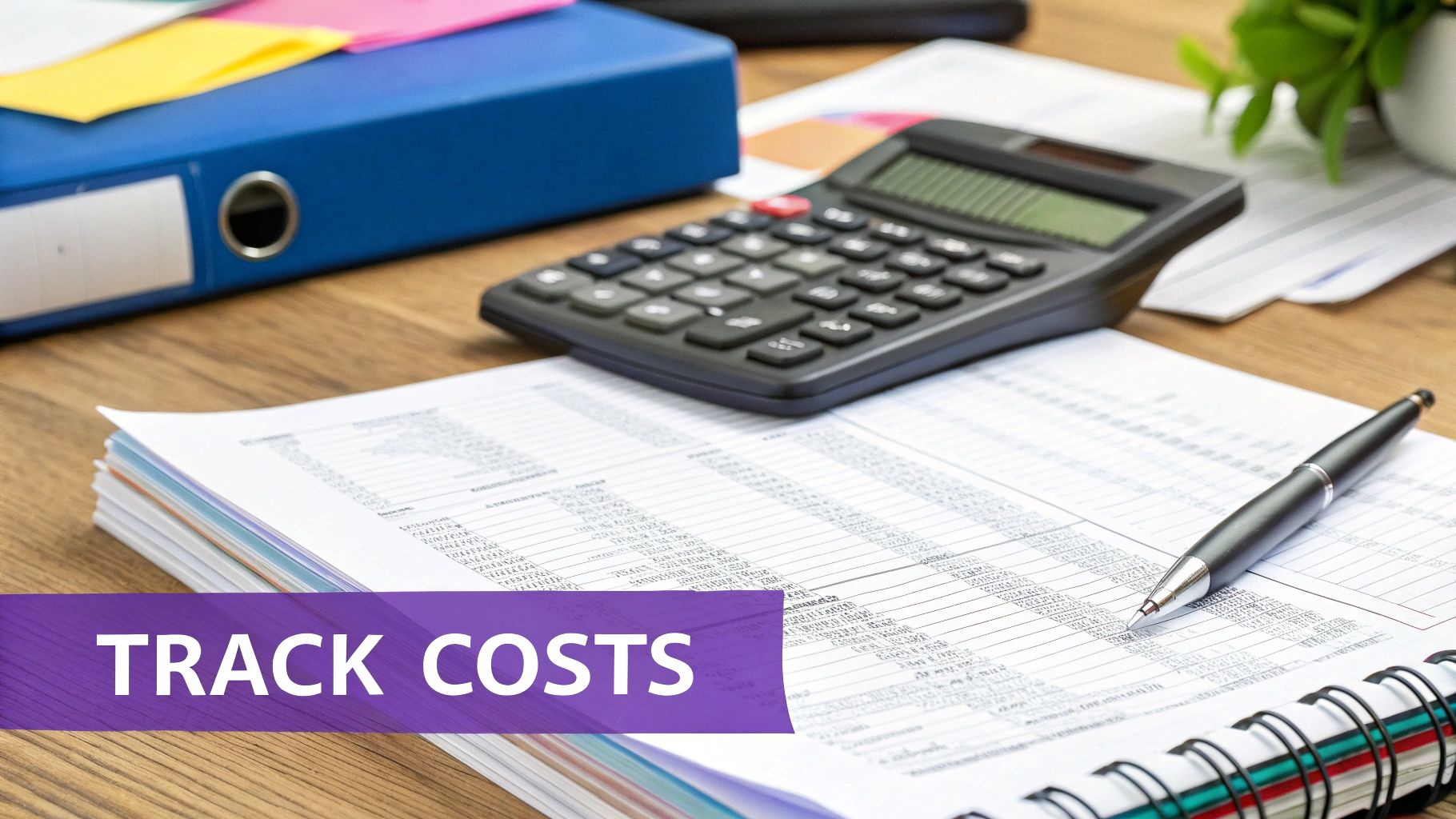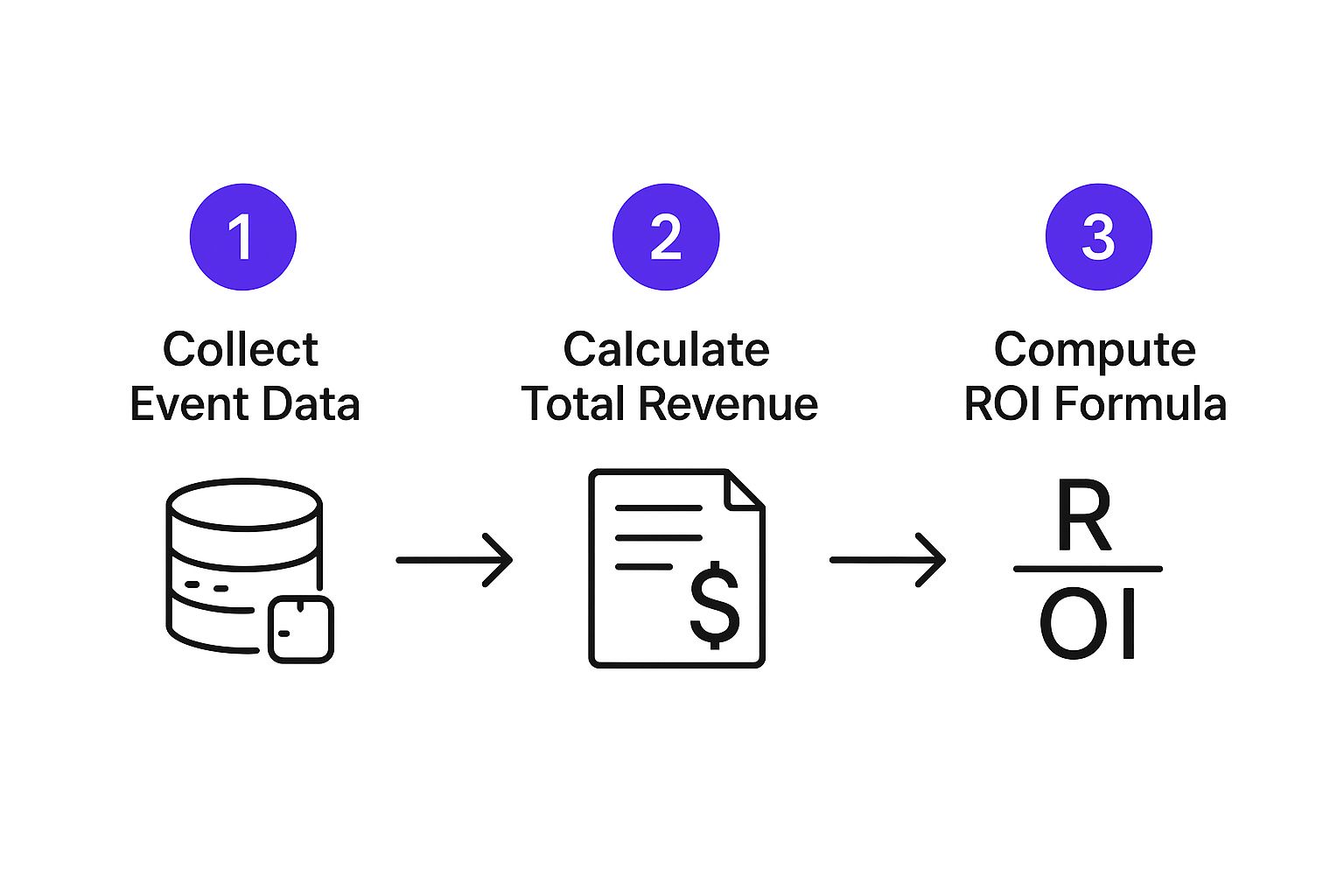How to Measure Event ROI: Proven Strategies for Success

Let's get real for a moment. Waving your hands and telling a good story about how great your last event was just doesn't work anymore when you're trying to justify a massive budget. If you want to prove your event's worth and secure that funding for the next one, you need to tie everything you do back to real business goals. This isn't just a "nice-to-have"; it's how you prove your team's impact.
Why a Modern Take on Event ROI Is a Must-Have Skill
In a world obsessed with data, your leadership team wants to see the numbers. They aren't moved by fluffy anecdotes. That's why knowing exactly how to measure your event's return on investment has become a core competency for modern marketers. With virtual and hybrid events now a permanent part of the playbook, we have more data than ever, but it also makes having a solid measurement plan absolutely critical.
The amount of money flowing into this industry is staggering. The global events market is on track to hit $1.34692 trillion by 2025, which is a huge leap from $1.2273 trillion in 2024. Here in the U.S., companies pour around $122 billion into event marketing every single year. These aren't small numbers; they show just how central events are to business growth. You can dig deeper into these event industry statistics and what they mean for your budget.
It's More Than Just a Simple Formula
Here’s the first mistake I see people make: they think ROI is just a simple (Revenue - Cost) / Cost calculation. A truly modern approach understands that an event's value isn't always measured in dollars and cents alone. Of course, revenue is a huge piece of the puzzle, but you have to account for all the other ways an event pushes the business forward.
You need to zoom out and look at the whole picture.
- Is it strategic? Did your event actually help the company achieve a bigger goal, like breaking into a new industry or launching that shiny new product?
- Is it backed by data? Can you walk into a budget meeting with a clear, numerical argument for what you need and later show what that investment produced?
- Does it give you an edge? Are you using what you learn from your ROI data to make your next event even better, leaving competitors who rely on guesswork in the dust?
The ultimate goal here is to shift the perception of your event from a line-item expense to a predictable source of revenue. When you can confidently show how your event filled the pipeline, sped up sales deals, or boosted customer loyalty, the conversation changes. It's no longer, "How much did you spend?" but rather, "What was the return?"
This mindset shift is what separates the event programs that thrive from the ones that constantly have to fight for scraps. It’s not just about proving a single event was a success; it's about building a reliable engine for business growth.
Defining What Event Success Actually Looks Like

Before you can even begin to talk about ROI, you have to ask a fundamental question: what does a "win" actually look like for this event? It’s a common trap to chase high attendance numbers, but that’s often just a vanity metric. It feels good, but it tells you very little about the real business impact.
True success is tied directly to your core business objectives. The goals you’d set for a lead generation conference are worlds apart from those for a brand activation or an internal training summit. Each event has a unique purpose, and that purpose should dictate the metrics you track.
Moving From Vague Ideas to Actionable Targets
So, how do you get specific? This is where the SMART goals framework comes in handy. It’s a classic for a reason. It forces you to move past fuzzy ideas and create targets that are Specific, Measurable, Achievable, Relevant, and Time-bound. This is how you turn a generic goal into a concrete performance indicator.
Let's take a common objective like "generate leads." On its own, it's pretty useless. But when we apply the SMART framework, it becomes something your team can actually work toward.
A SMART Goal in Action: "Acquire 200 new Marketing Qualified Leads (MQLs) from our annual user conference, representing a projected pipeline value of $500,000, all within 60 days of the event's conclusion."
See the difference? This goal isn't just specific; it’s directly tied to revenue, which makes calculating the "return" in your ROI much more straightforward. It gives your sales and marketing teams a clear target and a deadline.
Tailoring Goals to Your Event Type
Your objectives have to make sense for the kind of event you're hosting. A B2B tech company's user conference might be all about customer retention and upselling. On the other hand, a new consumer product launch is likely focused on generating media mentions and social media buzz. If you're looking for a deeper dive, our complete strategy guide for measuring event ROI breaks down even more scenarios.
Here are a couple of real-world examples to get you thinking:
- For a B2B Tech Conference: The goal could be to book 50 product demos with enterprise-level prospects on-site and convert 20% of those into qualified sales opportunities within the next quarter.
- For a Consumer Product Launch: A great goal would be to hit 5 million impressions on social media with the event hashtag and land feature articles in 10 key industry publications.
When you set these clear, tailored goals from the start, you're not just hoping for the best. You're creating a precise roadmap that will guide every other decision you make when measuring your event's ROI.
How to Track Your Total Event Investment

Before you can even think about measuring event ROI, you have to get brutally honest about what you actually spent. It’s a common pitfall. I’ve seen countless marketers track the big-ticket items—the venue, the catering, the keynote speaker—and call it a day.
That approach gives you a dangerously skewed picture. It leads to an inflated ROI that looks great on paper but doesn't reflect reality. To get it right, you need to dig deeper and account for every single dollar, both the obvious and the hidden.
Beyond the Obvious Line Items
The costs that truly wreck an event budget aren't always the ones on the main invoices. They're the "invisible" expenses that add up fast. Forgetting these can mean the difference between an event that was a genuine success and one that quietly bled money.
What are these hidden costs? They're things like:
- Promotional Spend: Think about everything you spent just to get people in the door (or on the webinar). This includes paid social campaigns, the cost of your email marketing platform, and any freelance writers or designers you hired.
- Tech Stack Subscriptions: Did you use a platform like Bizzabo for registration or a dedicated event app? Those subscription fees are a core part of your investment.
- Your Team's Time: This is the single most overlooked expense, and it’s a big one. The salaries of your team members who poured weeks or months into planning, managing, and following up on the event absolutely have to be counted.
How do you track this? It’s simpler than it sounds. Figure out a rough hourly rate for each person on the event team. Multiply that by the hours they spent on the project. These "soft costs" are a very real part of your total investment, and including them is non-negotiable for an accurate ROI.
Building Your Comprehensive Cost Checklist
To make sure nothing slips through the cracks, you need a system. I've found that grouping expenses into logical categories is the best way to stay organized and see exactly where the money went.
To give you a head start, I've put together a checklist of common event costs. Use this as a foundation to build your own detailed budget tracker.
Comprehensive Event Cost Checklist
Venue & Logistics
- Examples: Venue rental, A/V equipment, Wi-Fi, insurance, security, on-site staff.
- Tracking Tip: Get a fully itemized quote from your venue to avoid surprise fees.
Talent & Content
- Examples: Speaker fees, entertainer costs, moderator stipends, travel/lodging for talent.
- Tracking Tip: Clarify in the contract exactly what is covered (e.g., travel, meals).
Marketing & Promotion
- Examples: Paid ads, social media campaigns, PR agency fees, content creation, printed materials.
- Tracking Tip: Use dedicated tracking links for every campaign to see what drives registrations.
Technology & Software
- Examples: Virtual event platform, event app, registration software, lead capture tools.
- Tracking Tip: Many platforms bundle services. Check what’s included vs. what’s an add-on.
Internal Staffing
- Examples: Planners' salaries (pro-rated hours), travel and accommodation for your team.
- Tracking Tip: Use a simple time-tracking tool or spreadsheet to log hours spent on the event.
Attendee Experience
- Examples: Food & beverage, swag bags, gifts, name badges, post-event surveys.
- Tracking Tip: Order 10-15% more swag than your expected attendance to account for extras.
Having this complete picture of your investment is the essential first step. Once you have a firm handle on your total costs, you're ready to start connecting them to the value your event generated.
Tying Event Activities to Real Business Value

This is where many event marketers hit a wall. You know the event was a success—the energy was high, the feedback was great—but how do you actually prove it drove revenue? The answer is attribution: the process of connecting specific actions to tangible outcomes. Without it, you’re just guessing.
The real trick is to create clear, trackable pathways from your event activities directly back to your business goals. When it comes to financial returns, this means putting systems in place that can trace a lead from the moment you scan their badge on the event floor all the way through to a closed deal in your pipeline.
Here are a few practical ways to do this:
- CRM Integration: This is absolutely essential. Your event platform must talk to your CRM, whether it's Salesforce or HubSpot. Every single lead captured needs to be tagged with the event's name, allowing you to follow their journey and confidently attribute future sales to that specific interaction.
- Dedicated Landing Pages: Don't just send everyone to your homepage. Create unique landing pages for any event-specific offers, like a link to download your presentation slides or a special booking page for a follow-up demo. This isolates the traffic and makes conversion tracking clean and undeniable.
- Unique Discount Codes: If you sell a product directly, giving attendees a special discount code is one of the easiest ways to measure impact. Tracking how many times that code is used gives you a direct, dollar-for-dollar line to the sales your event generated.
When you're trying to connect all your event activities to business value, remember that even streamlined operations contribute to the bottom line. For example, knowing how to effortlessly sell event tickets simplifies a key part of the revenue equation right from the start.
Looking Beyond Direct Revenue
Not all value can be counted in dollars and cents, at least not at first. Some of the most significant returns from an event are measured in brand equity, audience engagement, and market perception. To get a complete picture of your event’s impact, you have to measure these non-financial returns, too.
Think about tracking metrics like these:
- Brand Sentiment: Use social listening tools to see how people talked about your brand before, during, and after the event. A noticeable shift toward positive language is a very real, measurable return.
- Media Mentions: Don't just count the articles; quantify their value. You can calculate the "earned media value" (EMV) to assign a rough dollar figure to the press coverage you received.
- Social Engagement: Track the growth in your follower count, the usage of your event hashtag, and the engagement rates across your social media channels during the event period. These are clear indicators of increased brand awareness.
Taking this holistic approach is vital. Measuring the ROI of large-scale or global events is incredibly complex precisely because they generate value in so many different ways. This is why advanced analytics and integrated data systems are no longer a "nice-to-have"—they're essential for painting a full, accurate picture of your event's performance and true impact on the business.
Calculating and Communicating Your Event ROI
Alright, you've done the hard work of tracking your costs and identifying your returns. Now it’s time to put it all together and get to the number that really matters: your event ROI. This single figure is the ultimate scorecard for your event's financial health.
At its core, the formula is simple. You're just comparing the total profit your event generated against what you spent to make it happen. The final percentage tells you exactly how much you earned for every dollar you invested.

As you can see, the calculation itself is straightforward. The real challenge—and where most people trip up—is making sure you have clean, accurate data to plug into the formula in the first place.
A Real-World ROI Calculation
Let's make this tangible. Imagine a B2B software company hosts a user conference. After adding up everything—the venue, marketing, travel, and even a portion of their team's salaries—their total investment comes to $100,000.
Now for the good part. From that event, they brought in:
- $40,000 from sponsors.
- $20,000 in ticket sales.
- $240,000 in new business pipeline that they can trace directly back to leads from the conference.
This gives them a total event gain of $300,000 ($40k + $20k + $240k).
Let's plug that into the ROI formula:
Event ROI = [($300,000 Total Gain - $100,000 Investment) / $100,000 Investment] x 100
This works out to a 200% ROI.
What does that mean? For every single dollar they spent, they generated two dollars in profit. That's a fantastic result that proves the event's value. Of course, what counts as "good" is subjective. Expectations can run high; in fact, 75% of companies with massive event budgets (between $50 million and $100 million) are looking for a return of at least 5:1.
Remember, the number itself is just the beginning. The real power comes from how you frame it. A 200% ROI isn't just a number; it's proof that your event is a profit center, not a cost center. For more tips, check out these strategies to boost your trade show ROI.
Sharing these results effectively is just as important as calculating them. This is where building relevant summary reports comes in. You need to present your ROI alongside other key metrics to tell a compelling story of success to your leadership and stakeholders.
Common Questions About Measuring Event ROI
https://www.youtube.com/embed/0zQmSIstt6o
Even the most seasoned event planners hit a few snags when it's time to tally up the final numbers. It's perfectly normal—calculating true event ROI has its quirks. Let's break down some of the most common questions I hear and give you some clear, practical answers.
When Should I Calculate My Final Event ROI?
This is a great question, and the answer isn't as simple as "the day after the event."
You can—and should—start tracking immediate wins right away. Metrics like initial lead counts, social media buzz, and immediate website traffic can often be compiled and reported within the first week. But that’s just the opening act. The real story, especially for B2B events with long sales cycles, unfolds over time.
The true revenue impact might not surface for 3-6 months. I always recommend a phased approach to reporting. Deliver initial results at 30 days, then follow up with updates at 90 and 180 days. This shows stakeholders the ongoing value and captures the long-tail conversions that are easy to miss.
How Do I Measure ROI for a Brand Awareness Event?
When brand awareness is the main goal, you have to think beyond direct sales. The "return" is measured in impact and influence, not just dollars and cents. Your focus shifts from a purely financial calculation to a more qualitative one.
Instead of tracking revenue, you'll want to measure key performance indicators like:
- Media Value: What's the value of the press coverage and articles your event landed? You can assign a monetary figure here.
- Social Reach: Look at the hard numbers—follower growth, hashtag usage, and your overall share of voice in the conversation.
- Website Traffic: Jump into your analytics. How many new visitors did you get from event-specific campaigns and channels?
- Brand Sentiment: This is a big one. Use post-event surveys to see if you actually moved the needle on how people perceive your brand.
You can then assign a value to these outcomes, like Earned Media Value (EMV), to create a comparable ROI figure that makes sense to leadership.
What Is a Good ROI for an Event?
There's no magic number here. A "good" ROI is completely relative and depends on your industry, event type, and specific goals. What's a home run for a brand-new product launch might just be par for the course for your big annual conference.
That said, a common benchmark in the B2B space is an ROI between 3:1 and 5:1. This means for every dollar you invest, you get $3 to $5 back in return. For newer events or those focused on brand building, even a 1:1 or 2:1 ratio can be a massive success. It proves the concept is profitable and gives you a solid baseline to improve upon next time.
This is also where your follow-up game becomes critical. Turning those new connections into actual business is what drives that final number up. To dig deeper, check out our guide on how post-event success turns connections into long-term relationships. Strong relationships are the bedrock of high-value returns.
Ready to turn your speaking engagements into a predictable source of leads and revenue? SpeakerStacks gives you the tools to capture audience interest in real-time and measure your event ROI with precision. Ditch the guesswork and start converting attention into pipeline. Discover how SpeakerStacks works.